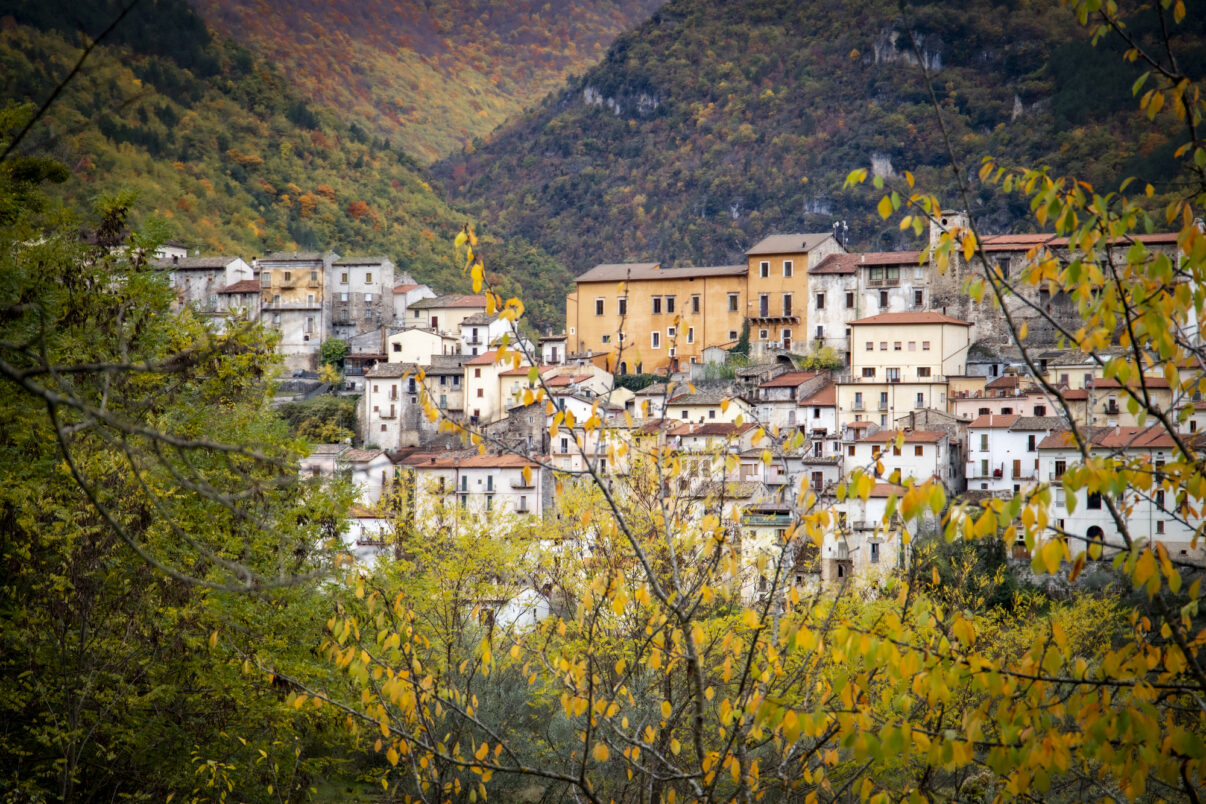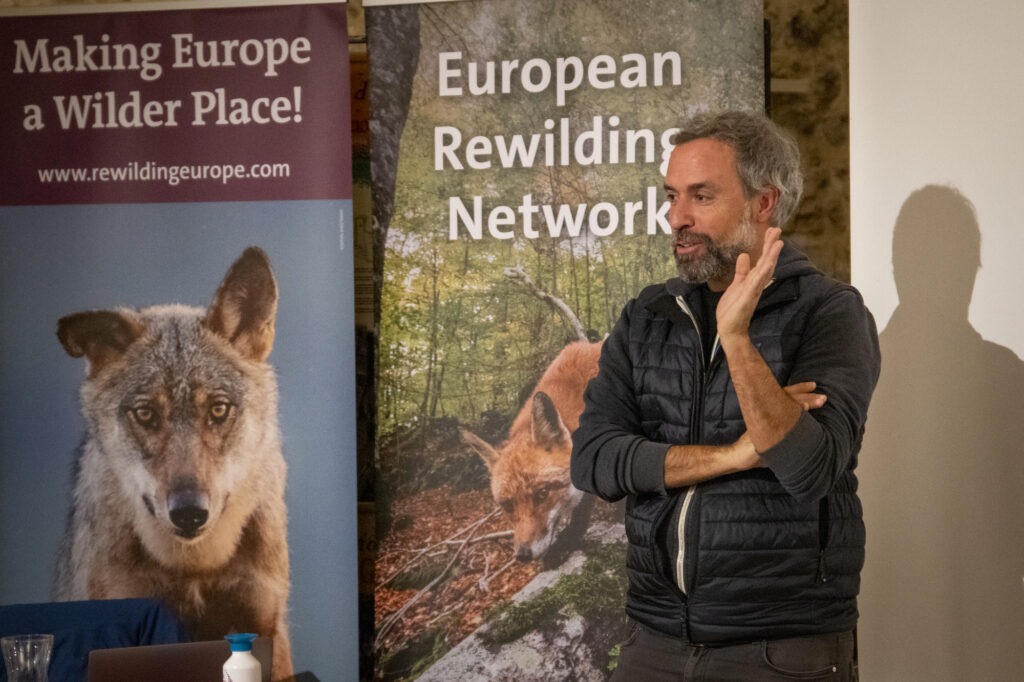In the heart of the Central Apennines rewilding landscape, the residents of Pettorano sul Gizio are benefitting from lives that are increasingly entwined with local nature.

Beauty and the beasts
From the vantage point of Piazza Rosario Zannelli, the ochre-tiled rooftops of Pettorano sul Gizio are surrounded by a sea of green, the forested slopes of nearby hills covered in a verdant blanket of pine, beech, oak, and ash. Today, this captivating panorama is enjoyed by growing numbers of visitors, who are drawn to this charming town in Italy’s Central Apennine Mountains to enjoy the culture, cuisine, and – increasingly – the local wild nature.
Officially listed as one of Italy’s “borghi piu belli” (most beautiful small towns), tiny Pettorano is the unlikely yet hugely appealing star of Central Apennine rewilding. Perched on a hilltop above the Gizio River, it is neatly sandwiched between two of the most important protected natural areas in the country – the Abruzzo, Lazio and Molise and Maiella National Parks. Both are home to a range of iconic wildlife – such as wolves, wild boar, Apennine chamois, red and roe deer, golden eagles, and griffon vultures – while the flagship species is the endemic and endangered Marsican brown bear, which boasts a small but slowly increasing population of around 60 individuals.
Flanking Pettorano is the Monte Genzana Alto Gizio Regional Nature Reserve, one of five areas that are being developed by the Rewilding Apennines team as large-scale coexistence corridors between these national parks and other important natural areas. By rewilding these corridors, and enabling and encouraging local communities to live alongside wildlife, the aim is to expand the territory into which animals can safely disperse and thrive.
The fall and rise of nature
While nature is always dynamic, man’s interference in the landscape often leads to rapid and dramatic change. If we could jump inside a time machine and travel back 120 years, the view from Pettorano’s Piazza Rosario Zannelli would be significantly less picturesque. A sepia photo taken from the square in around 1905 reveals hillsides almost completely stripped bare by a combination of livestock overgrazing, clearance for agriculture, and the efforts of local “carbonari” (charcoal makers).
Fast forward 40 years and Pettorano’s natural recovery began after the conclusion of the Second World War, as Italy entered a period of unprecedented economic growth and high population mobility. The disparity of wealth and of employment between urban and countryside areas triggered a period of intense rural depopulation across the Central Apennine region.
“There was a mass exodus of people to large cities, which left behind a vast expanse of unattended land,” says 44-year-old wildlife photographer and videographer Bruno D’Amicis, who moved to Pettorano with his family three years ago, having been drawn to the area’s wild nature. “This was the beginning of the rewilding process, as human pressure on the landscape around the town declined and nature started to bounce back.”
A socio-economic engine of change
Ensuring communities benefit economically from wildlife comeback has always been an integral part of the rewilding process, as it helps to further promote coexistence and generate additional support. In this way, the recovery of wild nature around Pettorano is now offering burgeoning opportunities to many of its residents, just as rewilding is acting as an engine of positive socio-economic change in every other landscape where Rewilding Europe and its partners operate.
“Thanks to the efforts of the Rewilding Apennines team, and partner NGOs such as Salviamo l’Orso (Save the Bear), Pettorano has become a real hotspot for rewilding and conservation enthusiasts,” says Bruno D’Amicis. “It’s been great to see increasing numbers of these people visit Pettorano, and even relocate here. It’s been an economic and social shot in the arm for the town.”
Located in one corner of Piazza Rosario Zannelli, Il Torchio is one of the most popular restaurants in Pettorano.
“We are now hosting many rewilding events,” says owner Milena Ciccolella. “These have been a real life-saver in economic terms, and have stimulated us creatively, as we now offer vegetarian dishes on our daily menu. We are also planning to offer cooking courses to ‘rewilding guests’. The recovery of nature is slowly but surely adding value to the Pettorano economy.”

Connecting with the wild
Across Pettorano’s social spectrum, rewilding is enabling and encouraging both residents and visitors to forge and reforge connections with nature. With iconic species such as the Marsican brown bear and Apennine chamois acting as ambassadors for the landscape, growing numbers of people are now exploring the town’s wild surroundings.
“The Covid-19 pandemic inspired me to start hiking in the mountains around Pettorano again,” says 55 year-old architect Massimo Ricciotti, a long-term resident of the town. “I’m so happy that bears have returned to this area. Usually, I walk in nature once a week – it’s a kind of therapy for me, a time where I can relax and clear my head. I know many other people who benefit in the same way.”
“I love it that we can see animals every day here,” says Bruno D’Amicis’s youngest son Nils, aged seven. “We can hike or play next to the river and go searching for animal tracks. I often spot roe deer and foxes from my school window or the schoolbus. In Pettorano I feel like I’m in nature, and that’s a good feeling.”
Want to know more?
This blog is taken from a longer story entitled “The town that went wild”, which featured in the Rewilding Europe Annual Review 2022.
Download a PDF of the story Or check out our Annual Review 2022

